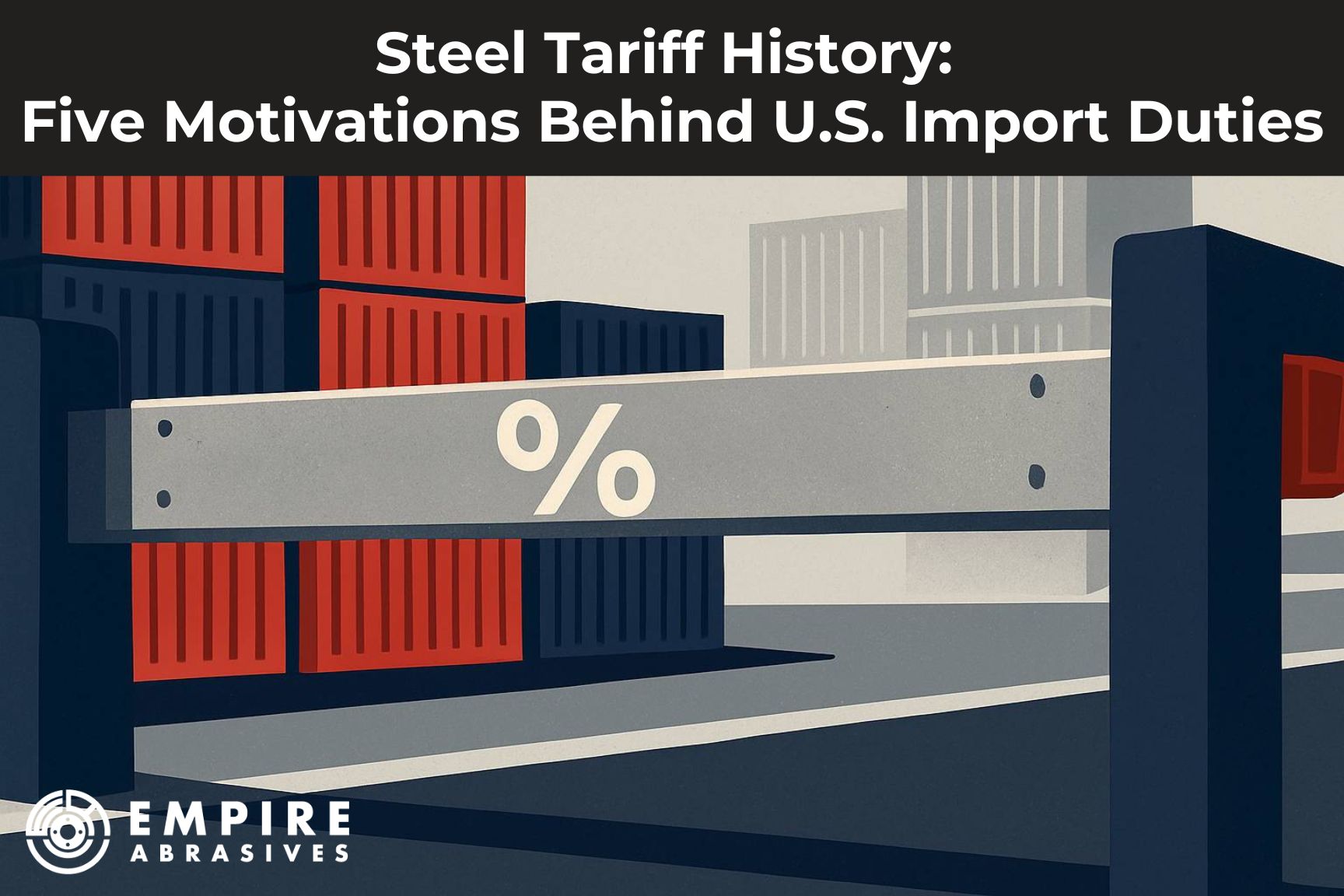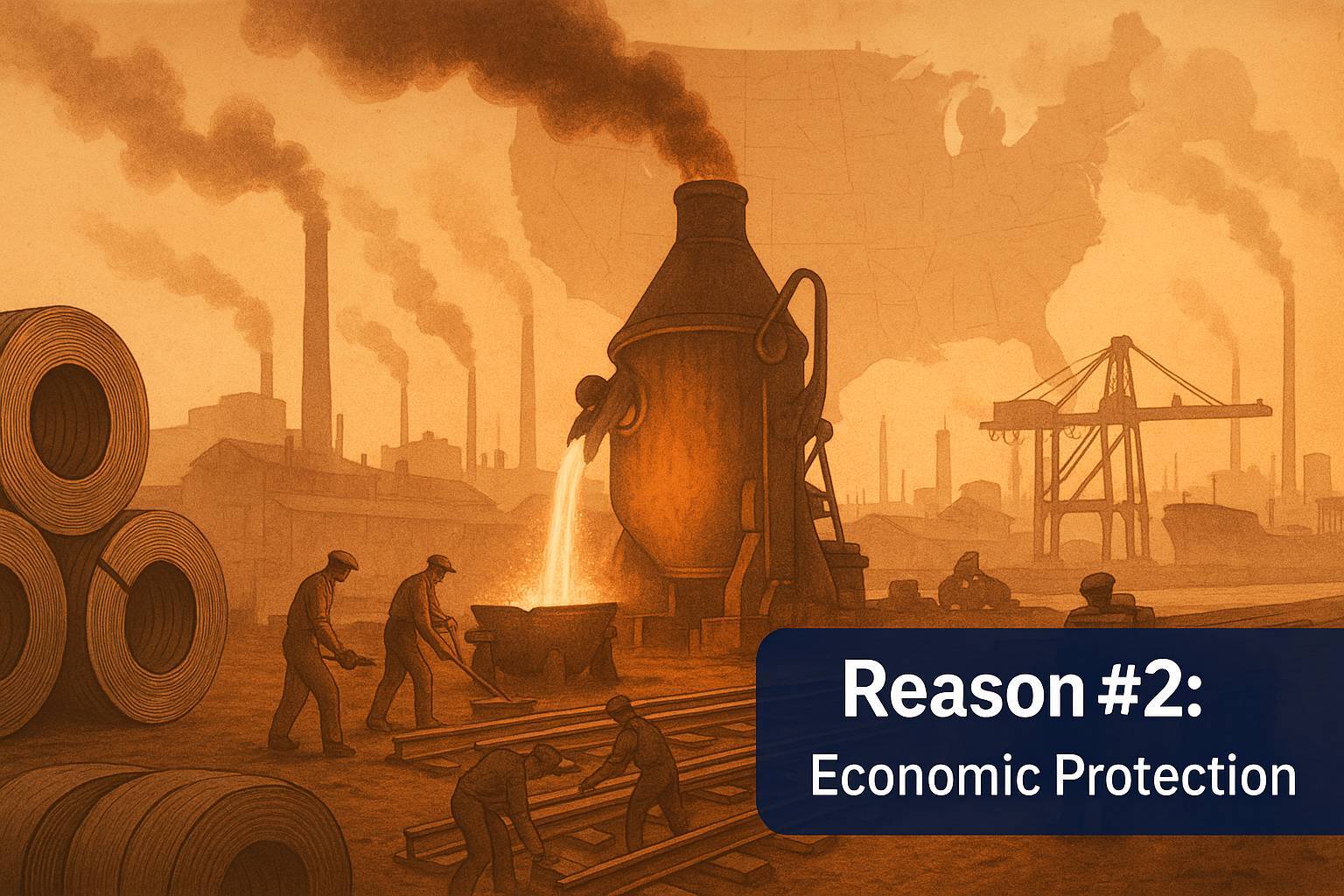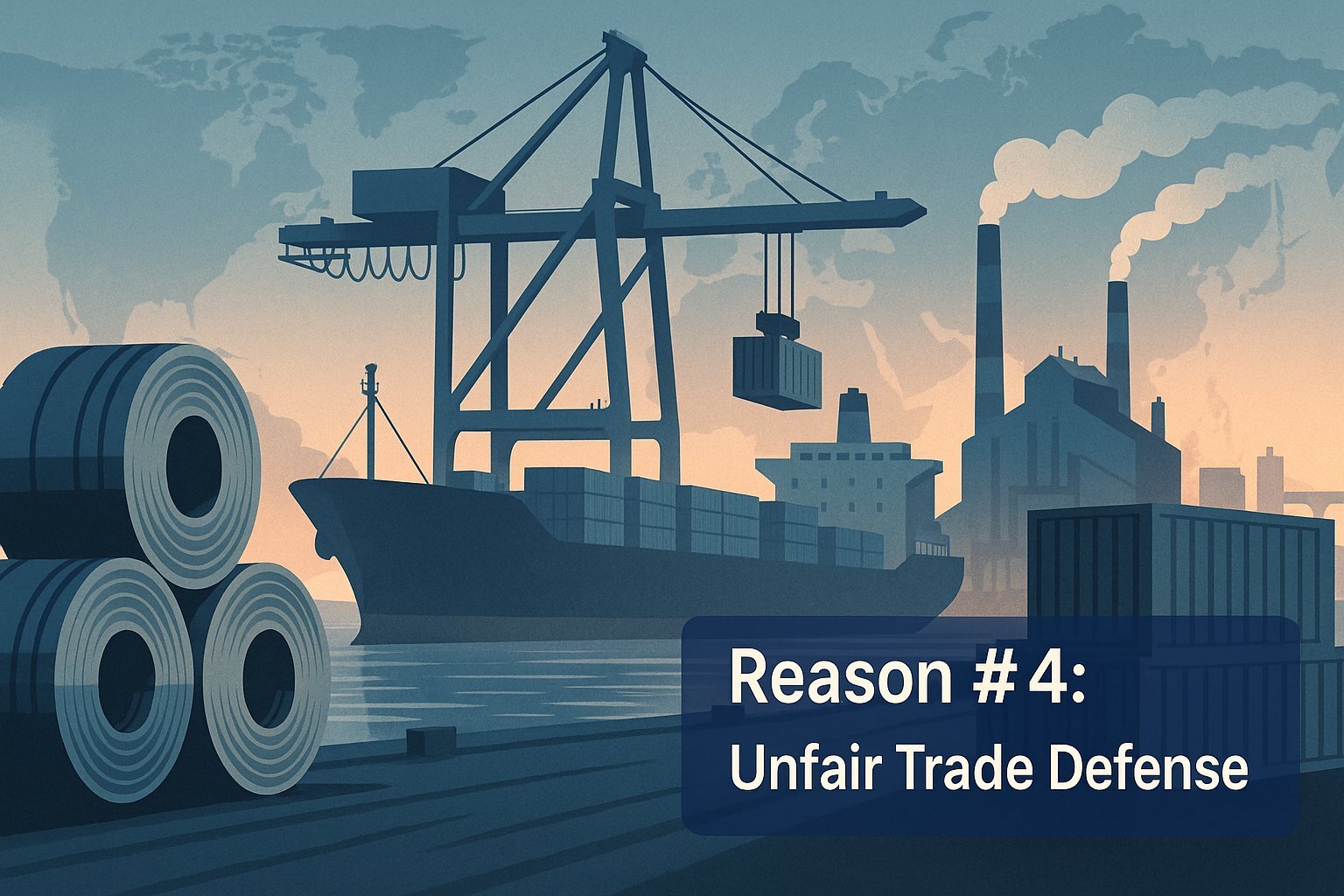
The United States’ 2025 wave of tariff news was kicked off with a 25% worldwide duty on steel (and aluminum). This isn’t the first time, nor will it be the last, that steel imports were a main focus of American tariff strategies.
At Empire Abrasives, we see firsthand how steel‑price volatility from these tariffs affects our customers’ margins and project timelines. We thought it mightbe interesting to talk about how these tariffs have historically been used to better understand today's landscape. - This article examines five major historical motivations that have consistently driven the implementation of steel tariffs in the United States
Why Do Steel Tariffs Happen? 5 Historical Reasons
Throughout American history, policymakers have turned to tariffs at pivotal moments—from early duties on sugar and textiles that funded the young republic, to the sweeping Smoot‑Hawley Tariff of 1930 designed to protect jobs during the Great Depression, and more recent levies on automobiles and semiconductors aimed at shoring up strategic industries. Steel, as the backbone of infrastructure, defense, and heavy manufacturing, has likewise been a recurring focus of these protectionist measures. Below, we explore five key motivations behind America’s steel tariffs and the historical episodes that brought each rationale to the forefront.

Reason #1 - Nurturing Domestic Industrial Growth
Tariffs have historically been a tool used to nurture domestic industries at a time when they were still developing. In early American history, competing globally with countries that already had established industries was a significant challenge. To address this, strategically important industries were shielded with tariffs, enabling emerging companies to build capacity, invest in technology, and ultimately achieve the economies of scale necessary for global competitiveness. The core principle is that this temporary protection would foster a more competitive and self-reliant industrial base in the long run.
Historical Context/Examples
- Alexander Hamilton’s 1791 Report on Manufactures - Hamilton argued that infant American manufactures—ranging from textiles to iron goods—required a temporary shield from low‑cost British imports via tariffs of up to 15 percent, subsidies, and internal‐improvement support measures to reach competitive scale. By early 1792, duties on imported manufactures rose from virtually zero to as high as 12.5 percent, laying the groundwork for a protectionist tariff strategy in the United States.
- Tariff of 1816 - In response to a post‑War of 1812 fiscal deficit and pressure from northern manufacturers, the Tariff of 1816 imposed average duties of 20–25 percent—including a 30 percent levy on iron* imports—explicitly to provide protection to the manufacturers of the United States” for three years.
- Tariff of 1824 - This tariff (part of the American System) aimed to specifically shield American manufacturers, particularly those in the wool, cotton, iron*, and glass industries, from foreign competition. This act further elevated duties on iron to roughly 35 percent.
Why are we talking about Iron?
Before steel became easier and cheaper to produce, iron held a similar, if not greater, level of importance in the global economy and for national power as steel does today. Iron was the predecessor to steel until advances in manufacturing techniques in the mid to late 1800s created a relatively inexpensive method for mass-producing steel.

Reason #2 - Boosting the Domestic Steel Industry (Economic Protectionism)
By the late 19th century, the positive impact of earlier protectionist measures on industrial growth, particularly in sectors like steel, was clear. The argument for tariffs then evolved from nurturing"infant industries" to maintaining workers' wages and bolstering domestic business.
During this period, a key driver behind rising steel tariffs became the desire to insulate the American steel industry from foreign competition. The strategy involved making imported steel more expensive to encourage domestic consumption. This aims to protect American jobs, investment, and production capacity in the steel sector.
Historical Context/Examples
- Tariff Act of 1870 (Steel Rails) - The 1870 Act imposed a specific duty of $28 per ton on imported British steel rails (then selling for about $31/ton), creating an effective import price of $59/ton versus $61/ton for domestic rails. By making imports scarcely cheaper than home‑grown steel, it encouraged U.S. mills to invest in the new Bessemer process and expand capacity. U.S. steel output rose from 22,000 tons in 1867 to over 11 million tons by 1900. This eventually led to America becoming a main exporter of steel rails.
- Late 19th Century: After the Civil War, the iron and steel industry became a well-organized interest group that consistently demanded and often obtained high tariffs to protect against foreign competition. The McKinley Tariff of 1890, while not solely focused on steel, raised duties on imported goods significantly, including more than 70% on imported tinplate (sheet steel coated with tin).

Reason #3 Protecting Domestic Jobs and Industry Stability
While related to economic protectionism, the emphasis here is on the direct impact on workers and communities. When a sudden influx of cheaper, imported steel enters the market, it can undermine domestic producers, leading to factory closures and job losses. Adding tariff barriers are an attempt to provide temporary relief that allows domestic industries to adjust to sudden shifts in market dynamics. This protection can prove critical in safeguarding not only the viability of these industries but also the livelihoods of millions of workers who depend on them.
Historical Context/Examples
- Dingley Act (1897) - Under President McKinley, the Dingley Act set the highest average U.S. tariff ever—around 52 percent in its first year and averaging 47 percent over its twelve‑year tenure—to secure jobs and incomes in steel, textiles, and other key sectors.
- Republican Platform (1896) - The 1896 GOP platform reaffirmed high tariffs as “the bulwark of American industrial independence” and pledged to “uphold the American standard of wages for the American workingman,” signifying a shift from purely nurturing young industries to cementing labor protection as a core trade policy goal. This wasn’t just a steel focused tariff, but tariffs overall.

Reason #4 - Combating Perceived Unfair Trade Practices
Another longstanding reason for imposing steel tariffs is to counteract what are seen as unfair trade practices by other nations. This rationale holds that when foreign steel is dumped (sold below fair market value) or backed by government subsidies, it distorts competition and harms U.S. producers. Tariffs and trade remedies—safeguards under Section 201, antidumping duties, and countervailing duties—are the primary tools to level the playing field by increasing import costs to domestic‑competitive levels.
Historical Context/Examples
- Late 20th-Century Trade Disputes: Over several decades, numerous cases surfaced in which domestic industries accused foreign producers of dumping steel on the market. These events led to the implementation of tariffs as part of a broader strategy to safeguard local industries from predatory pricing. Steel imports rose sharply in the late 1970s and early 1980s, triggering floods of antidumping, countervailing duty, and Section 201 safeguard petitions as U.S. output struggled to compete with low‑priced foreign steel.
- George W. Bush Administration, 2002: Invoking Section 201 of the Trade Act, President Bush imposed temporary tariffs of 8–30 percent on over 170 steel items starting March 20, 2002, to give U.S. firms relief from an injurious import surge. These measures were planned for three years and were lifted December 4, 2003.

Reason #5 - National Security and Self-Sufficiency
Governments have long viewed domestic production of steel as crucial for national security. Steel is a fundamental component of military equipment, shipbuilding, infrastructure, and industrial machinery—critical to defense readiness and economic stability. By imposing tariffs, the United States can aimed to secure a robust domestic steel industry capable of meeting strategic needs without relying heavily on foreign imports.
Historical Context/Examples
- Section 232 of the Trade Expansion Act (1962): In 1962, amid fears of Soviet embargoes and the need for assured steel supplies, Congress enacted Section 232 of the Trade Expansion Act to empower the President to impose or adjust tariffs if imports “threaten to impair national security”. This legislation reflected a shift in U.S. trade policy to include national security as a standalone justification for protecting industries like steel. Even though it wasn’t invoked frequently in the 20th century, the very existence of Section 232—specifically referencing national security—shows that policymakers at the time recognized the strategic necessity of a self-sufficient steel industry.
Summary Table of Key Historical Tariffs Discussed
|
Act / Policy |
Year (s) |
Primary Rationale* |
Key Rate / Duty |
Context & Impact |
|
Early Revenue & Infant‑Industry Duties (post‑Constitution) |
1790–1792 |
Nurture new manufactures |
Raised general import duties from 5 % to ≈ 12.5 % ad‑valorem |
Implemented recommendations of Hamilton’s Report on Manufactures; first broad move toward protective tariffs. |
|
Tariff of 1816 |
1816 |
Infant‑industry protection; fiscal revenue |
Average 20–25 %; 30 % on iron |
First explicitly protective tariff; sheltered U.S. iron makers after War of 1812. |
|
Tariff of 1824 (American System) |
1824 |
Deepen industrial growth |
Iron duties ≈ 35 % |
Extended high protection to wool, cotton, iron, glass; signalled long‑term commitment to industry. |
|
Steel‑Rails Duty (Tariff Act of 1870) |
1870 |
Boost domestic steel capacity |
$28 per ton on imported steel rails |
Virtually erased British price advantage; encouraged Bessemer investment, output boom to >10 Mt by 1900. |
|
McKinley Tariff |
1890 |
Protect mature industries |
> 70 % ad‑valorem on tinplate (sheet steel) |
Demonstrated political strength of iron‑steel bloc; raised overall duties ~ 49 %. |
|
Dingley Tariff |
1897 |
Safeguard wages & jobs |
Average ≈ 52 % (first year) |
Highest peacetime duties to date; framed as defending the “American standard of living.” |
|
Section 201 Steel Safeguard (Bush) |
2002–2003 |
Counter import surge / alleged dumping |
8–30 % (tiered) |
Temporary relief for domestic mills; lifted after 21 months under WTO pressure. |
|
Section 232 Authority (Trade Expansion Act) |
1962 → invoked 2018 & 2025 |
National security & self‑sufficiency |
Authorises tariff action when imports “threaten to impair” security; most recently a flat 25 % on all steel |
Establishes legal basis for security‑driven tariffs; 2025 proclamation re‑applied full rate on every source. |
Reflecting on Two Centuries of Tariffs
From the earliest duties recommended by Alexander Hamilton to the security‑driven actions of the 1960s and beyond, steel tariffs have been repurposed time and again to meet America’s evolving objectives. Whether to jump‑start manufacturing, protect livelihoods, level the playing field, or safeguard defense interests, these measures underscore the versatility of tariff policy. Today’s debates benefit from appreciating that history.
